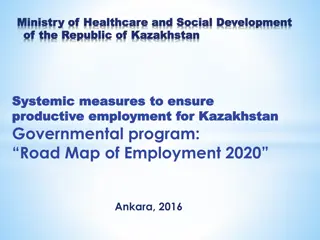European Unemployment: Outcomes and Outlook Analysis
Prakash Loungani, an advisor at the IMF, presents a comprehensive analysis of European unemployment rates, outlining the dire outlook and discussing whether the issue is cyclical or structural. The presentation includes data on unemployment rates in various European countries, changes in unemployment rates from 2007 to 2012, Euro Area GDP growth forecasts, and Euro Area unemployment rate forecasts. The focus is on understanding the current state of European unemployment and providing insights into potential solutions. IMF recommendations are also discussed.
Download Presentation

Please find below an Image/Link to download the presentation.
The content on the website is provided AS IS for your information and personal use only. It may not be sold, licensed, or shared on other websites without obtaining consent from the author. Download presentation by click this link. If you encounter any issues during the download, it is possible that the publisher has removed the file from their server.
E N D
Presentation Transcript
EUROPEAN UNEMPLOYMENT: OUTCOMES AND OUTLOOK Prakash Loungani Advisor, Research Department, IMF Co-Chair, Jobs & Growth Working Group, IMF April 17, 2013 VIEWSEXPRESSEDARETHOSEOFTHEPRESENTERANDSHOULDNOTBEASCRIBEDTOTHE IMF . I thank Ezgi Ozturk for excellent research assistance.
Outline 1. Unemployment: outcomes and outlook 2. Diagnosis: cyclical or structural? 3. IMF advice
1. European Unemployment Outcomes: Dire Outlook: Dire
Unemployment Rate: 2012 30 25 20 15 10 5 0 Denmark Germany France Ukraine Latvia Ireland Croatia Bulgaria Estonia Slovenia Finland Czech Republic Spain Portugal Albania Lithuania Italy Poland United Kingdom Sweden Belgium Serbia Hungary Romania Moldova Austria Turkey Greece Norway Netherlands Switzerland Slovak Republic
Change in Unemployment Rate: 2012-2007 20 15 10 5 0 -5 France Ukraine Latvia Romania Estonia Croatia Bulgaria Slovenia Czech Republic Finland Turkey Lithuania Portugal Italy United Kingdom Denmark Albania Sweden Belgium Spain Serbia Hungary Moldova Poland Austria Germany Ireland Norway Greece Netherlands Switzerland Slovak Republic
Euro Area GDP Growth Forecasts in 2007 3 2 1 0 -1 -2 -3 -4 -5 2008 2009 OECD EO (December 2007) WEO (October 2007) Actual
Euro Area Unemployment Rate Forecasts in 2007 12 10 8 6 4 2 0 2008 2009 OECD EO (December 2007) WEO (October 2007) Actual
Unemployment Rate: 2013 WEO Forecast 30 25 20 15 10 5 0 Denmark Germany France Ukraine Ireland Latvia Croatia Bulgaria Estonia Slovenia Czech Republic Finland Portugal Albania Lithuania Italy Poland United Kingdom Belgium Sweden Serbia Spain Hungary Turkey Romania Moldova Austria Greece Norway Netherlands Switzerland Slovak Republic
2. Diagnosis: Cyclical or Structural Largely cyclical Risk of turning structural ( hysteresis )?
A Debate since the 1970s We impute the higher [European] unemployment to welfare states' diminished ability to cope with more turbulent economic times, such as the ongoing restructuring from manufacturing to the service industry, adoption of new information technologies, and a rapidly changing international economy. (Ljungqvist and Sargent, 1998) There is sometimes the na ve belief that unemployment must be due to a defect in the labor market, as if the hole in a flat tire must always be at the bottom, because that is where the tire is flat (Solow, 2000). "It takes a heap of Harberger triangles to fill an Okun's gap. (Tobin, 1977)
Unemployment during the Great Recession Initial increase cyclical rather than structural Greater uncertainty about relative proportions now, but remains largely cyclical in our view Beveridge curve quite stable; moreover shifts may not be sign of increase in natural rate (Diamond 2013) Other measures of mismatch back to normal Lack of deflation not a sign of small unemployment gap Stability of Okun s Law (even during the Great Recession) suggests jobs will return if the growth returns. 1 1
Stability in Beveridge Curve in Most Countries (relative to past changes) Graph shows average percent point deviation in the unemployment rate. Source: Hobijn and Sahin (2012) 12
Correlation between Change in Unemployment and Change in GDP (2012, in percent) 7 All European Countries 6 5 Change in Unemployment 4 3 2 1 0 -1 -2 -3 -8 -6 -4 -2 0 2 4 6 Real GDP Growth
Correlation between Change in Unemployment and Change in GDP (2012, in percent) 7 Euro Area 6 Change in Unemployment Rate 5 4 3 2 1 0 -1 -2 -3 -8 -6 -4 -2 0 2 4 Real GDP Growth
Framework Large increase in unemployment in advanced economies during the crisis Cyclical or structural unemployment? How to achieve the relative price adjustment in periphery Euro countries? Can labor market reforms reduce the natural unemployment rate and raise potential growth? Recent Staff Discussion Note (Blanchard, Jaumotte, Loungani) looks at IMF advice in this light 1 6
Recommendations: Monetary & Fiscal Policy Diagnosis that unemployment problem is largely cyclical has framed IMF advice on labor markets Fiscal stimulus and monetary easing early in the crisis Now, fiscal consolidation should be gradual, with credible medium-term plans Effects of fiscal consolidation on growth should be offset by other measures to the extent possible Continued ease in monetary policies Financial sector repair & reform 1 7
IMF leadership on fiscal issues widely recognized How the IMF became the friend who wants us to work less and drink more -- Washington Post April 16, 2013 IMF Renews Push Against Austerity It is to the credit of the economists at the Fund that their recommendations to policymakers have adapted to this strange world we re living in rather than sticking with their more normal, doctrinaire advocacy of monetary and fiscal restraint.
IMF leadership on fiscal issues widely recognized How the IMF became the friend who wants us to work less and drink more -- Washington Post April 16, 2013 IMF Renews Push Against Austerity -- Wall Street Journal April 17, 2013 It is to the credit of the economists at the Fund that their recommendations to policymakers have adapted to this strange world we re living in rather than sticking with their more normal, doctrinaire advocacy of monetary and fiscal restraint.
IMF Renews Push Against Austerity the International Monetary Fund called on countries that can afford it -- including the U.S. and Britain -- to slow the pace of their austerity measures. The fund warned that "overly strong" belt-tightening in the U.S. will slow growth this year. Across-the-board government spending cuts, known as the sequester, were the "wrong way" to shrink the budget deficit, it said in its semiannual report on economic growth. Those cuts should be replaced by more targeted reductions that would take effect further down the road -- after the economy gains strength, the report said. The U.K. government, which in 2010 embarked on a closely watched effort to escape its slump through tax increases and spending cuts, also should consider easing up on its austerity drive amid a weak recovery there, the IMF said. And it warned euro-area policy makers against focusing too much on hitting tough deficit targets, saying they risked further deepening their downturn.
IMF Renews Push Against Austerity the International Monetary Fund called on countries that can afford it -- including the U.S. and Britain -- to slow the pace of their austerity measures. The fund warned that "overly strong" belt-tightening in the U.S. will slow growth this year. Across-the-board government spending cuts, known as the sequester, were the "wrong way" to shrink the budget deficit, it said in its semiannual report on economic growth. Those cuts should be replaced by more targeted reductions that would take effect further down the road -- after the economy gains strength, the report said. The U.K. government, which in 2010 embarked on a closely watched effort to escape its slump through tax increases and spending cuts, also should consider easing up on its austerity drive amid a weak recovery there, the IMF said. And it warned euro-area policy makers against focusing too much on hitting tough deficit targets, saying they risked further deepening their downturn.
IMF Renews Push Against Austerity And it warned euro-area policy makers against focusing too much on hitting tough deficit targets, saying they risked further deepening their downturn. "Fiscal adjustment needs to proceed gradually, building on measures that limit damage to demand in the short term," the IMF said. The IMF also called on countries like Germany that have traditionally relied on exports for growth to lift spending to stimulate their economies and, the IMF hopes, imports from the country's struggling neighbors. "There is a need for higher demand" in countries with big trade surpluses, IMF Managing Director Christine Lagarde said in a speech last week. "For countries in Northern Europe, like Germany, it means doing more to boost investment."
Recommendations: Labor Market Policies Extension of unemployment benefits Iceland, Greece But reduction in Portugal Targeted interventions to help some groups Youth; Low-skilled; Long-term unemployed (see chart that follows) Move away from duality Too late to stop layoff of temporary workers But reduction in employment protection on permanent contracts could help hiring as recovery takes hold 2 3
Recovery differs across groups Youth (aged 15-24) Older workers (aged 55-64) Low-skilled (aged 25-64) High-skilled (aged 25-64) 115.0 110.0 105.0 100.0 95.0 90.0 Ratio of each group's employment relative to overall employment, a OECD average, b 2008 Q1-2011 Q4, index = 100 at the start of the crisis 24
Competitiveness In some Euro area countries, need reduction in relative wages Best way to achieve would be through national tripartite agreement Experience of Latvia, Ireland, Greece Without such an agreement More flexibility in wage-setting Reduction in public sector wages Reduction in minimum wage Fiscal devaluations Higher inflation in North relative to South 2 5
Medium-run Growth Higher potential growth and lower natural rate of unemployment desirable Product market reforms essential for medium-run but can hurt in the short-run Labor market reforms move away from duality more flexible wage-setting Reduce tax distortions to raise participation, particularly for females Raising retirement age and adjusting benefits to raise participation of older workers 2 6























